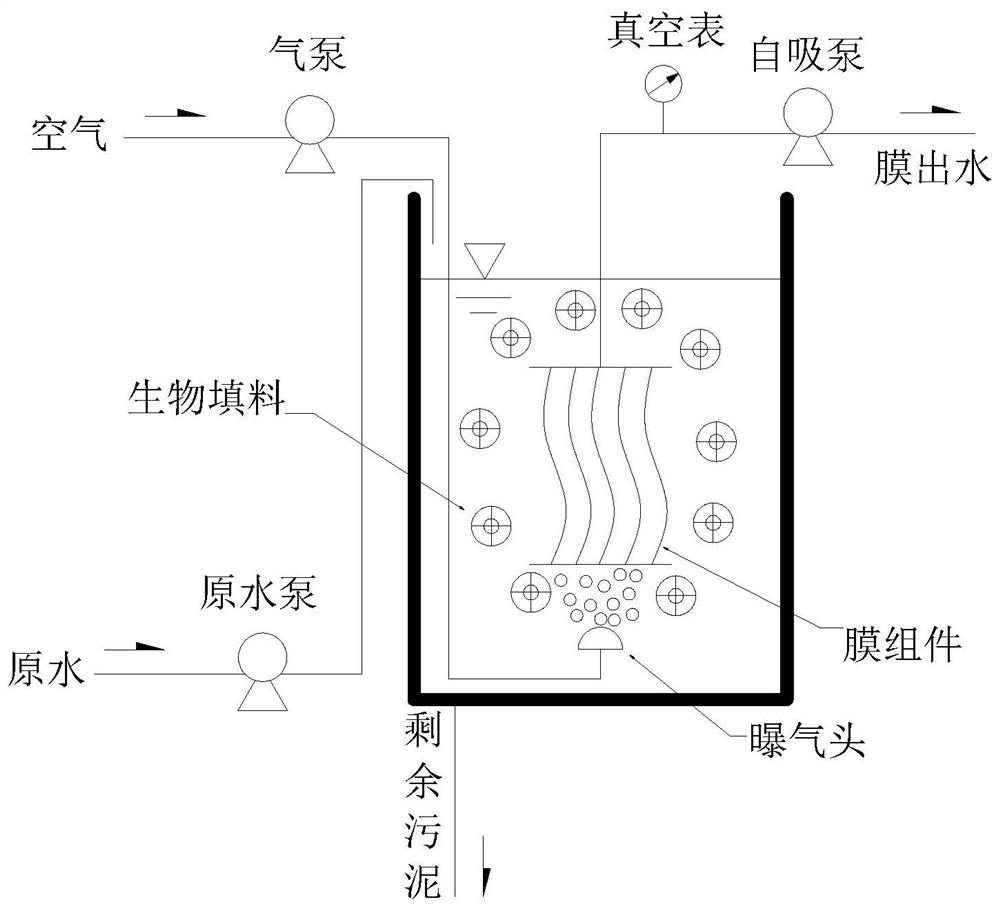A method for controlling membrane fouling in hmbr
A technology of membrane pollution and population, which is applied in the field of water pollution treatment, can solve problems such as cumbersome operating procedures, and achieve remarkable effects, long operating cycles, and no increase in operating costs
- Summary
- Abstract
- Description
- Claims
- Application Information
AI Technical Summary
Problems solved by technology
Method used
Image
Examples
Embodiment 1
[0014] The dominant microbial populations in the activated sludge were cultivated as: Proteobacteria (Proteobacteria) accounted for 28% of the total amount of bacteria; followed by Acidobacteria (Acidobacteria) accounted for 13% of the total amount of bacteria; Bacteroides (Bacteroidetes), accounting for 10% of the total number of bacteria.
[0015] At this time, the alpha diversity analysis results of the activated sludge microbial population showed that the chao index was 1058.4, the ace index was 862.6, the shannon index was 4.29, and the simpson index was 0.0142. The richness and diversity of species in the activated sludge were very good. At this time, the dominant microbial populations in the filter cake layer were: the microorganisms with the largest amount were Proteobacteria (Proteobacteria), accounting for 35.4% of the total amount; followed by Bacteroidetes (Bacteroidetes), accounting for 14.2% of the total amount; Is Acidobacteria (Acidobacteria), accounting for 12...
Embodiment 2
[0017] The dominant microbial populations in the activated sludge were cultivated as: Proteobacteria (Proteobacteria) accounted for 45% of the total amount of bacteria; followed by Acidobacteria (Acidobacteria) accounted for 18% of the total amount of bacteria; Bacteroides (Bacteroidetes), accounting for 15% of the total number of bacteria.
[0018] At this time, the Alpha diversity analysis results of the activated sludge microbial population showed that the Chao index was 1072.3, the Ace index was 880.5, the Shannon index was 5.32, and the Simpson index was 0.0156. The species richness and diversity in the activated sludge were very good. At this time, the dominant microbial populations in the filter cake layer were: the microorganisms with the largest amount were Proteobacteria (Proteobacteria), accounting for 37.5% of the total amount; followed by Bacteroidetes (Bacteroidetes), accounting for 13.9% of the total amount; Is Acidobacteria (Acidobacteria), accounting for 12.5%...
Embodiment 3
[0020] The dominant microbial populations in the activated sludge were cultivated as: Proteobacteria (Proteobacteria) accounted for 31.6% of the total amount of bacteria; followed by Acidobacteria (Acidobacteria) accounted for 15.5% of the total amount of bacteria; Bacteroidetes accounted for 11.6% of the total bacteria.
[0021] The alpha diversity analysis results of the activated sludge microbial population at this time showed that the chao index was 1078.4, the ace index was 882.9, the shannon index was 5.19, and the simpson index was 0.0152. The richness and diversity of species in the activated sludge were very good. At this time, the dominant microbial populations in the filter cake layer were: the microorganisms with the largest number were Proteobacteria (Proteobacteria), accounting for 36.1% of the total amount; followed by Bacteroidetes (Bacteroidetes), accounting for 13.4% of the total amount; Is Acidobacteria (Acidobacteria), accounting for 13.0% of the total. Un...
PUM
 Login to View More
Login to View More Abstract
Description
Claims
Application Information
 Login to View More
Login to View More - R&D
- Intellectual Property
- Life Sciences
- Materials
- Tech Scout
- Unparalleled Data Quality
- Higher Quality Content
- 60% Fewer Hallucinations
Browse by: Latest US Patents, China's latest patents, Technical Efficacy Thesaurus, Application Domain, Technology Topic, Popular Technical Reports.
© 2025 PatSnap. All rights reserved.Legal|Privacy policy|Modern Slavery Act Transparency Statement|Sitemap|About US| Contact US: help@patsnap.com

